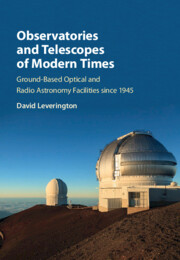 Observatories and Telescopes of Modern Times
Observatories and Telescopes of Modern Times from Part 2 - Radio Observatories
Published online by Cambridge University Press: 15 December 2016
Radio astronomy took some time to take off in America after the pioneering observations of Karl Jansky in 1932 and of Grote Reber in the late 1930s and early 1940s. This was in spite of the tremendous advances in radio technology achieved during the Second World war. Although the US Army Signal Corps had detected radar signals from the Moon in 1946, this was not for astronomical purposes but was a test of their system to detect incoming missiles from the Soviet Union.
At the end of the Second World War American astronomers had access to the best optical telescopes in the world and the Palomar 200 inch was also shortly to become available. In addition the climate in the United States, particularly on the west coast, was generally good for optical observations. So observational astronomers in America saw no need to get involved in the new-fangled field of radio astronomy which required new technical skills that they generally did not have. They were also generally sceptical that radio observations would yield much in the way of useful astronomical results. In Europe, on the other hand, the climate was generally not as conducive for optical observations as in America and large optical telescopes in Europe were not as good. But the climate was no limitation for radio observations. So a new set of observational astronomers, largely ex radio and radar engineers and physicists, grew up in Europe after the Second World War devoted to radio observations. A similar situation prevailed in Australia which also suffered from a lack of top quality optical telescopes, although they did not have the same climate problem as in Europe.
By the early 1950s radio astronomy was beginning to produce interesting results. At that time it became clear in the United States that, unless a bold approach was taken, it would continue to fall further and further behind other countries, particularly the United Kingdom and Australia, in radio astronomy. As a result, a number of American organisations had either started to develop radio telescopes or were considering doing so.(1) Then in January 1954 an interdisciplinary conference took place on radio astronomy, jointly sponsored by the American National Science Foundation (NSF), the California Institute of Technology (Caltech) and the Department of Terrestrial Magnetism of the Carnegie Institution.
To save this book to your Kindle, first ensure no-reply@cambridge.org is added to your Approved Personal Document E-mail List under your Personal Document Settings on the Manage Your Content and Devices page of your Amazon account. Then enter the ‘name’ part of your Kindle email address below. Find out more about saving to your Kindle.
Note you can select to save to either the @free.kindle.com or @kindle.com variations. ‘@free.kindle.com’ emails are free but can only be saved to your device when it is connected to wi-fi. ‘@kindle.com’ emails can be delivered even when you are not connected to wi-fi, but note that service fees apply.
Find out more about the Kindle Personal Document Service.
To save content items to your account, please confirm that you agree to abide by our usage policies. If this is the first time you use this feature, you will be asked to authorise Cambridge Core to connect with your account. Find out more about saving content to Dropbox.
To save content items to your account, please confirm that you agree to abide by our usage policies. If this is the first time you use this feature, you will be asked to authorise Cambridge Core to connect with your account. Find out more about saving content to Google Drive.